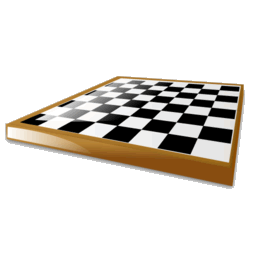Chess Rules and Gameplay
Chess Gameplay
The player controlling the white pieces moves first.
After the initial move by white, chess players alternate moves. Play continues until a
draw is called or a king is trapped by means of a checkmate (see below).
Chess Pieces
|
King
|
|
|
Queen
|
|
|
Rook
|
|
|
Bishop
|
|
|
Knight
|
|
|
Pawn
|
|
Movement of Chess Pieces
Each piece moves in a different way. Generally, a piece cannot pass through squares
occupied by other pieces, but it can move to a square occupied by an opposing piece,
which is then "captured" (removed from the board). Only one piece can occupy a given square.
- The rook moves orthogonally to the players (forward, backward, left or right) any number of squares.
- The bishop moves diagonally any number of squares.
- The queen moves orthogonally or diagonally, any number of squares.
- The king moves orthogonally or diagonally only one square at a time.
- The knight moves in an "L"-shape (two spaces in one direction and one space orthogonally to it). It is the only piece that can jump over other pieces.
- The pawn moves one space straight forward (away from the player). On its first move it can optionally move two spaces forward. If there is an enemy piece diagonally (either left or right) one space in front of the pawn, the pawn may move diagonally to capture that piece. A pawn cannot capture or jump over a piece directly in front of it.
Besides these moves, the king and either rook can do a special combination move called
castling: if the king and rook have not moved yet, and all spaces between them are empty,
then the king can move two squares toward the rook, and in the same turn the rook can move
to the space the king has just skipped over. It is not permitted to castle when the king
is threatened or would have to move through a threatened square. In serious play, care
must be taken to make clear that castling is intended, e.g. by verbal announcement or
by moving the king first (since the king cannot move two squares except in castling).
A pawn reaching the final rank becomes a queen in a process known as "queening" or
"promotion" (or, if the player prefers, a rook, bishop or knight; this is called
"underpromotion").
If a pawn moves two squares forward on its first move, it can be captured on the
square it has skipped over, as if it had moved only one square, but only during
the turn immediately after its two-square move and only by another pawn. This is
called capturing en passant.
In serious chess play, if a chess player having the move touches one of his pieces
then he must
move it if it can be legally moved. If a chess player touches a hostile piece then he must
capture it if the piece can be captured. So long as the hand has not left the piece
to be moved, the latter can be placed on any accessible square. If a player wishes to
touch a piece with the sole intention of adjusting its position on a square, he must
first apprise his opponent of his intention by saying J'adoube or I adjust. Only the
chess player whose turn it is to move may adjust a piece.
Check and checkmate in chess
When a chess player makes a move that threatens the opposing king with capture, the king
is said to be in check. If a player's king is in check then the player must make a
move that eliminates the threat of capture, which does not necessarily mean the king
must be moved. The possible moves to remove the threat of capture are:
- Move the king to a square where it is not threatened.
- Capture the threatening piece.
- Place a piece between the king and the opponent's threatening piece.
- A player may never leave his king in check at the end of his move.
In informal chess games, it is customary to announce check when making a move that puts
the opponent's king in check. However, in formal competitions this is not only
unnecessary but may be considered annoying or distracting.
If a chess player's king is placed in check and there is no legal move that player can make
to escape check, then the king is said to be checkmated, the chess game ends, and that player
loses.
Back to Games
